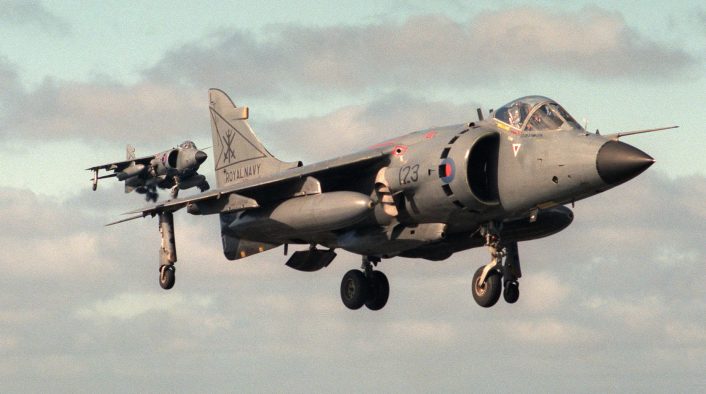The SHAR was a truly multi role aircraft that could perform air-to-air combat and ground attack and reconnaissance. First air-to-air engagement took place on the morning of May 1, 1982.
Known by its pilots as “SHAR,”30 years ago the Bae Sea Harrier embarked on its first combat mission.
It was April 5, 1982 when two UK’s “through-deck cruisers” (aircraft carriers) leave Portsmouth for their involvement in the Falklands conflict. On board were 20 BAe Sea Harriers, only in service since 2 years.
The British “Jump Jets” were heading to their baptism of fire, vastly outnumbered by proven supersonic weapons systems such as the Mirage III and the Mirage V Dagger, and no one really knew how it would perform against a real world shooting opponent; the Royal Navy’s Harriers had been up against F-5Es, F-4s and F-15s in Dissimilar Air Combat Training and more than held its own.
But real combat was a different matter.
The Sea Harrier was a modified Harrier featuring a slightly different cockpit layout and the Blue Fox multimode radar, something other versions of the Harrier did not possess.
The SHAR was a truly multi role aircraft that could perform air-to-air combat and ground attack and reconnaissance.
First air-to-air engagement took place on the morning of May 1, 1982, when a pair of Sea Harriers on CAP (Combat Air Patrol) near Port Stanley, were vectored onto three slow moving aircraft that had departed the local airfield. The three aircraft turned out to be T-34s that were made aware of the Harriers’ presence and hid in low cloud.
One of the SHAR managed to fire some 30mm cannon rounds in the general direction of the turboprops but the first contact ended with a no-score draw .
It didn’t take long for full on dogfighting to take place against the Mirage III.
It was on the afternoon of May 1st. HMS Glamorgan vectored a pair of SHAR towards three targets approaching at supersonic speed. As the SHAR turned towards the threat, the three targets turned away and used their superior speed advantage to escape. The SHAR returned to their CAP station until a few moments later the Glamorgan controller announced that the targets had returned and were descending in bound at some 25 miles away.
The SHAR immediately turned towards the targets, and decided to perform the hook manoeuvre: the lead aircraft flew head-on to the target and the wingman split to swing around to attack the targets from the rear.
The lead plane was unable to get a lock onto the fast approaching Mirage aircraft but the Hook maneuver worked perfectly as the Mirage pilots didn’t spot the wingman turning onto their tails until it was too late.
The wingman got his tone and released the AIM-9 Sidewinder air-to-air missile, that hit the Mirage for the first Sea Harrier’s confirmed kill.

The Navy’s SHARs went on to score 20 kills (none of which was achieved using the famous trick of stopping the plane midair by pointing the jet nozzles slightly forward inducing a 2g deceleration) to no loss in air-to-air combat. However, two were lost to ground fire (radar guided 30mm AA and a Roland missile) and a further two were lost to accidents during the conflict.
The kill-to-loss ratio does not reflect the skill and braveness of the Argentinean pilots who had to face a truly astonishing fighter, which had remarkable slow flight characteristics, even without the thrust vectoring, and a superior radar.

The Sea Harrier went on to see action in both Gulf Wars and in the Balkans conflict, which saw a Sea Harrier shot down by a SAM whilst attacking two tanks (the pilot ejected and managed to evade capture before returning to ship).
The original Sea Harrier FRS1 was superseded in 1993 by the mark II version, dubbed Sea Harrier FA2. The radar was upgraded to a pulse Doppler radar which gave the SHAR the ability to fire the AIM-120 AMRAAM and give it BVR (Beyond Visual Range) capability for the first time, was described at the time as the most advanced system in the world and made its way, in an updated/modified version, into the Eurofighter Typhoon.
The Sea Harrier was retired in 2006 few years earlier than the RAF GR9s, cut ahead of schedule as a consequence of the British Defense spending review.









